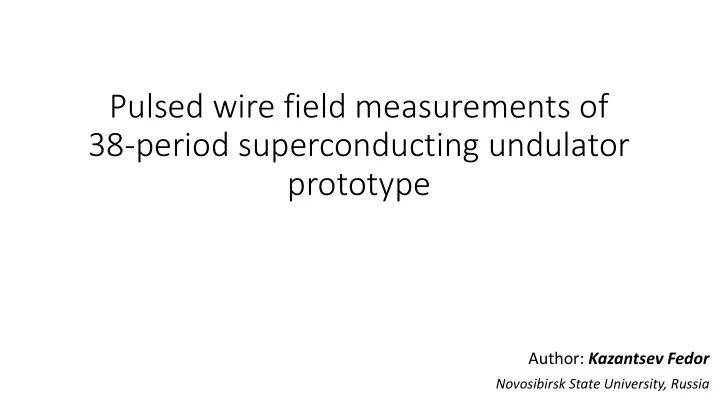

Pulsed wire field measurements of 38-period superconducting undulator prototype Author: Kazantsev Fedor Novosibirsk State University, Russia
Theory [wire-based measurement methods] There are 3 wire-based methods. All of them are based on the similarity of the interaction of an accelerated charged beam and a conductor with an electric current with a magnetic field. The difference is which kind of current is applied to the wire: • DC (Displacement of the wire at the ends of the magnetic device are being explored) • AC (Resonance vibrations of the wire are being explored) • Pulse (A wave that occurs when a short current pulse applied to the wire is being explored) In the Pulsed method (PWM), a short (~ 1-100 μs ) current pulse, from a unit to tens of amperes, is passed through a wire. Due to the influence of a magnetic field, the wire is deformed, then the resulting deformation propagates along the wire as the acoustic wave. This wave is detected by a wire position sensor located outside the undulator. Data from the sensor directly shows the first or second integral of the field, depending on the pulse duration.
PWM Advantages: • Almost no limits on magnetic device aperture . Wire diameter is close to typical beam transverse size (0.1 mm). • Rapid data obtaining. Measurements can be made every few seconds. • Both transversal components can be measured simultaneously. Disadvantages (problems): • Wave dispersion. Signal is need to be corrected via Fourier analysis. • Wire is very sensitive to vibrations (incl. sounds) of the environment. • Wire sagging.
Experimental setup wire undulator wire position sensor pulse generator
Wire position sensor wire slit light source photodiode
Test undulator (outside the cryostat) Parameters: • Period ≈ 3 cm • Field amplitude = 0.75 Tesla • K ≈ 2.2
Results [Raw data from wire position sensor, CuBe wire ∅ 200 µ m] 35 A 35 A 5 µ s 100 µ s
Results [“preparations” , brass wire ∅ 140 µ m] Calibration curve of wire position sensor Sensitivity – 0.283 Volts /µ m undulator borders sensor wire sagging
Results [Raw data from wire position sensor, brass wire ∅ 140 µ m] Wave reflection 30 A 30 A 10 µ s 100 µ s
Results [reconstructed, brass wire ∅ 140 µ m, 30 A 10 µ s pulse] 60+160 A in SC coils 160+60 A in SC coils
Further work • Find the dependence of wire displacement on field amplitude and integral value • Obtaining 1 st and 2 nd field integrals separately from each other • Wire vibrations (caused by environment) suppressing:
Thank you for attention! Note: This paper is based on my bachelor diploma work and will be continued
Recommend
More recommend